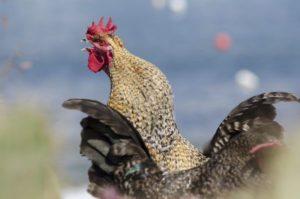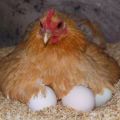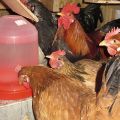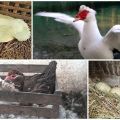How to make a do-it-yourself nest for laying hens with an egg collector at home
The correct arrangement of the poultry house has a positive effect on the egg production rate and the quality of eggs. The presence of nests or specially prepared places for laying hens is a prerequisite for breeding and keeping birds. You can build nests to accommodate chickens yourself, or you can purchase them in livestock stores.
Requirements for nests for laying hens
Any chicken perches must be built and installed with basic requirements in mind. In particular:
- For flooring in the nest, you can use straw or sawdust. The lower part is recommended to be made of metal mesh to ensure constant ventilation of the nests.
- Homemade perches should be placed in such a way that there is free space to the floor.
- The number of nests is calculated based on the chicken population.
- The perches should not be placed close to the walls, since with the onset of winter it is colder in such places than in other parts of the house.
- The material used to create the perches is pre-polished and only short nails are used to connect the parts. The protruding sharp parts are cut and rubbed with a file to prevent injuries to the hens.
Dimensions and placement
Regardless of the type of socket chosen, it is recommended to adhere to standard dimensions. The depth of the roost for laying hens varies between 30-40 cm, taking into account the size of the bird, and 30 cm in width and height. The optimum height above the floor is 30-35 cm. The take-off bar should be located 10 cm away from the entrance to the nest and have a cross section of 5 x 2.
The placement of perches is performed on the basis of previously prepared drawings, where the free area and dimensions of the internal elements of the house are determined. Drawings are necessary for any number of perches, including for 20 or more birds. Places for birds should be comfortable and not create problems when cleaning the chicken coop. It is important to provide open access to them for periodic collection of eggs and renewal of the mat. If the hens do not lay eggs in the designated area, they are moved to a better position.

Types of nests and their features
Different types of nests differ in design features, manufacturing method and certain advantages. To choose the best option, you should familiarize yourself with all offers. There are the following varieties:
- Perches in crates.The resemblance of chicken houses outwardly resembles a box with an entrance opening. A space is formed inside for the solitude of birds and the laying of eggs. Having installed a similar design, it is easy to train chickens to fly in nests, closing them inside for a while.
- Nests from scrap materials. This option is suitable for novice poultry farmers who did not manage to properly equip the chicken coop. It is also an optimal solution for small livestock and temporary breeding of birds. The main requirement is that all materials at hand must be intact and clean.
- Nest with egg collector. The collection of eggs is carried out from special trays, and the layers interact with the eggs for a short amount of time. When self-made, a funnel-shaped hole is made in the central part of the perch.
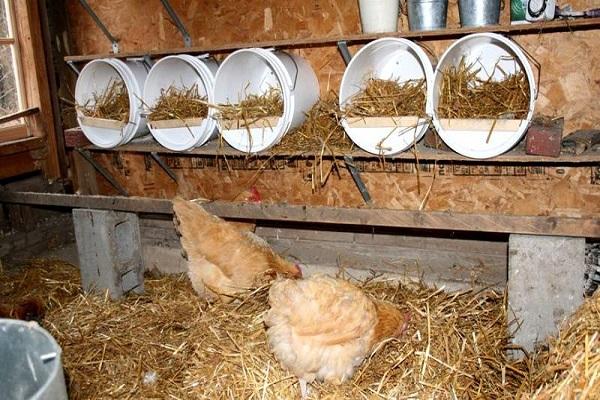
How to make nests for chickens with your own hands
When constructing perches for chickens at home, you first need to decide on a suitable variety and prepare a drawing. The manufacturing process depends on your own requirements for the finished structure.
A nest made of scrap materials
If you need to equip the poultry house in a short time, you can make perches for chickens using scrap materials. In particular, cardboard boxes, crates, buckets and other containers are suitable. Often, farmers even use rubber tires and fittings with compartments.
The selected containers at hand should be spacious enough so that the chickens are comfortable inside. The surfaces of the materials must be carefully inspected so that they are free of defects, falcons and signs of decay. The containers are placed in a chicken coop, filled with hay or sawdust and covered with curtains.
In most situations, such structures perform a temporary function and are used until the acquisition or creation of more durable ones.
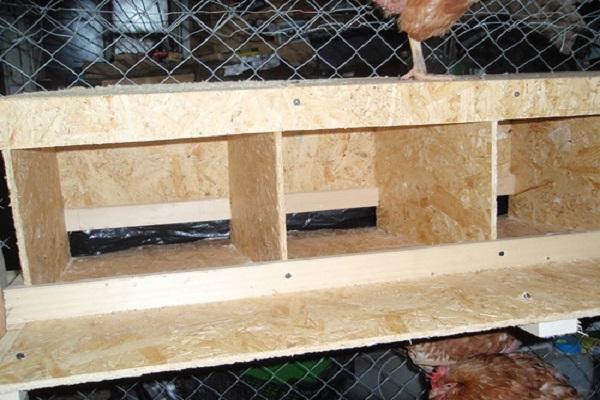
Regular socket
It is possible to build a conventional structure of wood, plywood or OSB boards without special skills and experience. The construction is not labor intensive and will not take a lot of time. Roosts can be single or multi-tiered. For construction, you need to prepare the basic material, fasteners (screws, nails, screws), sandpaper, a block, a hammer and a saw. To build a footprint, you need to sequentially perform the following steps:
- Determine the technical parameters, calculate the number of seats and draw up visual drawings.
- Process the material with sandpaper or a file to smooth out sharp corners and rough spots.
- Make structural blanks and, if there are any defects, re-grind.
- Connect the cut out parts to each other and fix the block from the inner corners. The presence of a bar gives the resulting capacity additional rigidity.
- Provide access to the perch by leaving the front open, or by nibbling and opening a small opening. At the bottom of the structure, a threshold is built with a height of about 10 cm.
- At a distance of 10 cm from the entrance to the nest, fix the rail in a horizontal state, which will serve as a take-off platform for chickens.
After completing the construction of the nest, you need to carefully examine it. In the presence of sharp corners, protruding screws and other defects, the problems should be eliminated in order to exclude a traumatic situation.
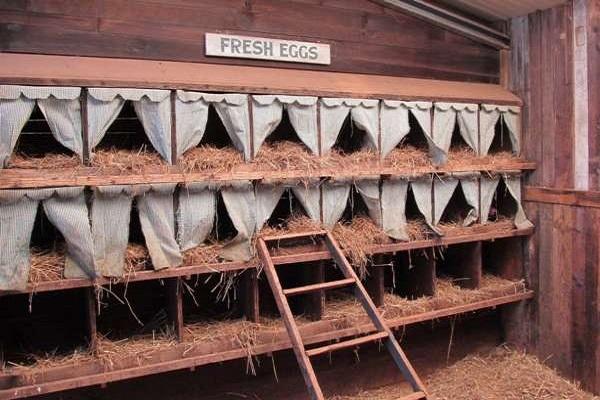
Egg collector nest
A perch equipped with an egg collection box is a device that helps reduce the labor of the poultry farmer. The structure can be made with a special container under the perch or with a double bottom. When choosing the second option, you will need to use a soft material for upholstery of the second bottom, for example, linoleum, felt or fabric. The material is fixed with the wrong side up.
In addition to ease of use, the need to install a perch with an egg collector arises so that chickens with an aggressive character do not peck eggs. Once on the pallet, the eggs end up in a space confined from birds. To make trap nests, you need:
- Draw a drawing and make blanks based on it. Then the structural elements are to be processed with a file and sandpaper.
- The lower part of the perch is fixed at a slope of about 5 degrees in relation to the rear wall. A small space must be left between the surface of the wall and the bottom edge so that the egg can pass through the gap.
- The pan for collecting eggs is made more elongated, 10-15 cm larger than the main structure. The bag is trimmed with woven material and a wooden strip is fixed on the front.
- By analogy with the bottom of the perch, the egg collector is fixed at a slight slope.
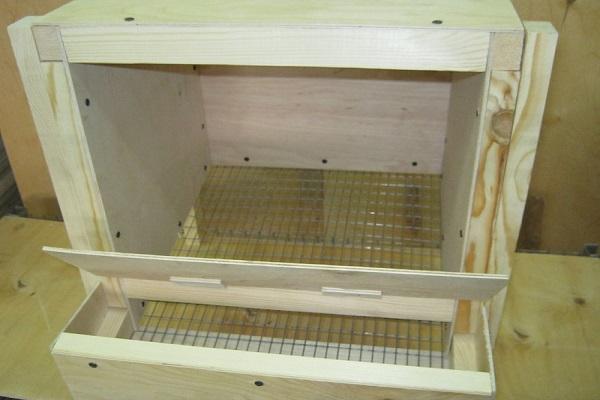
A nest with a container for collecting eggs is made in the same way, with one difference. Instead of a gap between the bottom and the back wall, a slot is made in the lower cavity of the container, the diameter of which is slightly larger than the size of a chicken egg.
Frame socket
The main advantages of the frame structure are strength and a long operating period. To build this type of nest, you will need a standard set of materials and tools. The process of constructing a hen seat involves collecting a frame from wooden blocks and sheathing with plywood. The installation of the egg collector is optional and is optional for the poultry farmer..
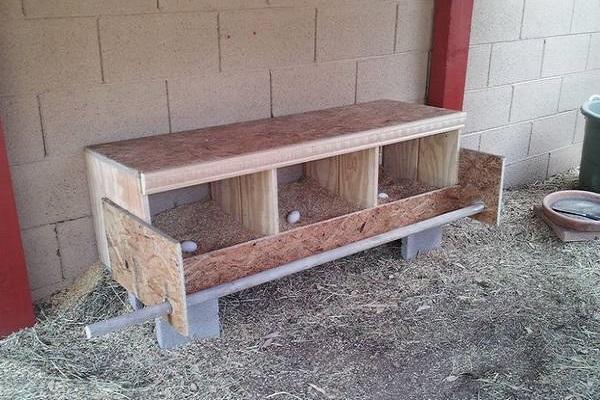
Metal socket
Building a metal perch will take more time and will be more difficult than building a wooden structure. At the same time, the iron perch is several times more resistant to external influences and has a long service life. To carry out the work, you will need to use a grinder for metal, a perforator and screws. Materials will require metal pipes with a cross section of 3-5 cm, sheets of galvanized steel and wire or steel mesh. To make a construction, you need:
- Draw a diagram of the future structure, mark the markings on steel sheets and make blanks.
- Cut out the bottom of the seat from the mesh or twist a similar piece of wire.
- Connect the walls and the bottom with screws, placing the bottom at a 10-degree slope, and then attach the roof.
- Set up a container for collecting eggs, which is cut from steel sheets and lined with cloth.

We fix the nests in the chicken coop
The perches in the house should be secured so that the hens are comfortable to sit in and lay. It is preferable that the nests are not in contact with the walls of the hen house. The most common option is the construction of special supports that are fixed on the walls. The stands are made from ordinary wooden planks of suitable length, and screws and hinges are used as fasteners.
How to train a hen to nest?
To accustom the bird to the nest, you can forcibly restrict its access to free movement and periodically leave it on the roost. As a less aggressive method, you can put objects in the seats that look like chicken eggs.

